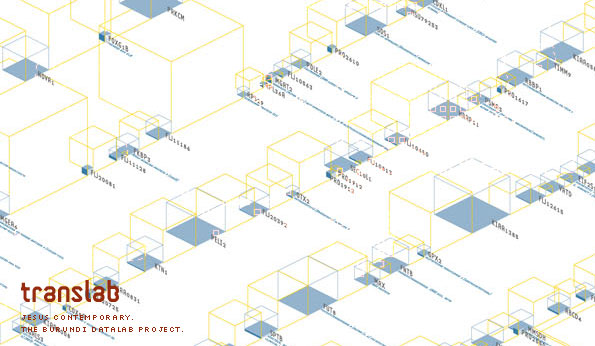
|

|

[sci] 2003 Joint press release of Craig Venter's Celera Genomics corporation and consortium of instutions in China, France, Germany, Japan, UK and US announce that the aim of The Human Genome Project to map the human genome down to the nucleotide (or base pair) level and to identify all the 30-35,000 genes present in it, has been completed successfully, with 99% of the genome sequenced with 99.99% accuracy.   |
|

|

|

|

|
[lit] 2002 Florian Cramer and August Highland start Nettime unstable digest, a weekly collection of artistic codework, code poetry gathered from various mailing lists.   |
|

|

|

|

|
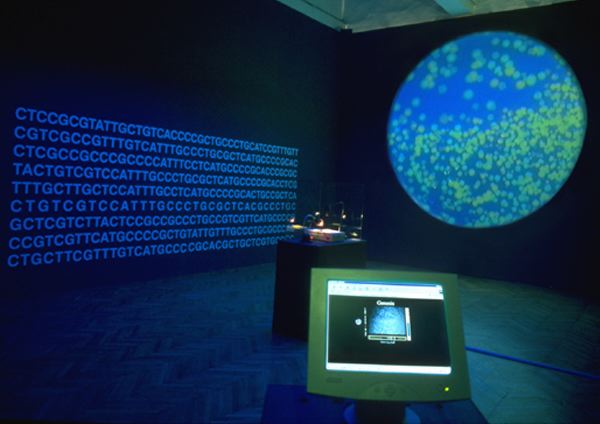
[art] 1999 Eduardo Kac's transgene project Genesis is exhibited for the first time at Ars Electronica in Linz. He creates the synthetic gene translating a sentence from the biblical book of Genesis into Morse Code, and then converting it into DNA base pairs. The sentence reads: "Let man have dominion over the fish of the sea, and over the fowl of the air, and over every living thing that moves upon the earth." The gene is incorporated into bacteria, which are shown in the gallery. Participants on the Web can turn on an ultraviolet light in the gallery, causing real, biological mutations in the bacteria. This changes the biblical sentence in the bacteria.   |
|

|

|

|

|
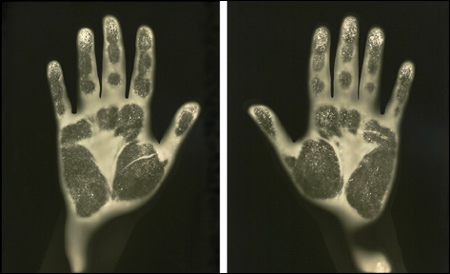
[art] 1996 Photographer Gary Schneider starts his work on series of photographs responding to revolutionary discoveries that are emerging from the Human Genome Project. Combining his interests in self-portraiture and biology, Schneider consults with doctors and geneticists, examines diagnostic and forensic photographs, as well as X rays, radiographs, photograms and micrographs of specimen samples of various parts of his own body. The photographic installation of 14 works called Genetic Self-Portrait is exhibited at the International Center of Photography in 2000.  |
|

|

|

|

|
[art] 1992 David Kremers starts his paintings with transgene bacteria. He uses bacteria genetically engineered to produce enzymes of various colors. In an incubation chamber bacterial colonies grow on plates of clear acrylic, creating various shapes and colors. At certain time point, the plates are dried and sealed in a synthetic resin. However, the resin may be removed and bacteria revived to continue the artwork.  |
|

|

|

|

|
[phil] 1979 Jean-Francois Lyotard in Postmodern Condition essay opposes the modern knowledge with the „ignorance“ and apply „functional“ perspective on knowledge in postmodern era, where the knowledge is digitizable (ie clear radio transmission), while noise not digitizable into categories, what puts it outside our systems of data collection / organization / preservation, disrupting orderly flow of knowledge / production (ie disrupted radio signal).  |
|

|

|

|

|
[art] 1970 MoMA's Information (curated by Kynaston McShine) and Jewish Museum's Software – Information Technology: Its New Meaning for Art (curated by Jack Burnham) conceptual art shows open in New York City. The same year, video magazine Radical Software published by Beryl Korot, Phyllis Gerhuny, and Ira Schneider starts its 4-year existence. The common motif here is the focus on art as a form of information processing (software) as opposed to the creation of traditional art objects (hardware).  |
|

|

|

|

|
[art] 1965 Mathematician and philosopher Friedrich Nake develops a programming language Comparter ER 56 and interested in probability theory, random numbers and the works of Hans Hartung and Paul Klee he starts to use the language to create his own computer visuals.  |
|

|

|

|

|
[sci] 1963 Kenneth Knowlton develops the first specialised computer animation language in Bell Labs. Beflix produces images at a resolution of 252 x 184 in 8 shades of grey. Beflix-generated films, created using an IBM 7094 computer and Stromberg-Carlson 4020 microfilm recorder, cost approximately $500 per minute of output. Beflix operations include: draw straight lines (from dots), draw curves, copy region, move region, solid fill area, zoom area, dissolve image transition.  |
|

|

|

|

|
[sci] 1960 William Fetter produces first ever computer-generated images of the human figure. As a Boeing employer he is trying to find a way to design an airplane cockpit. Fetter coins the term computer graphics in order to describe his creations. The human model is completed in 1964.  |
|

|

|

|

|

[sci] 1953 James Watson and Francis Crick decipher the molecular structure of the DNA, suggesting that DNA--not a protein, as is widely imagined--is the master molecule that contains genes, self-replicates and recombines during reproduction.   |
|

|

|

|

|
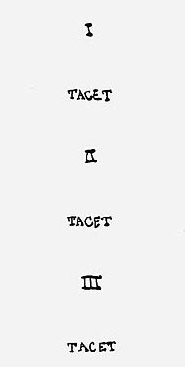
[snd] 1952 As opposed to minimally redundant Music of Changes, John Cage composes maximally redundant piece 4'33". The premiere is given by David Tudor on August 29 at Woodstock, New York as part of a recital of contemporary piano music. The audience saw him sit at the piano, and lift the lid of the piano. Some time later, without having played any notes, he closed the lid. A while after that, again having played nothing, he lifted the lid. And after a period of time, he closed the lid once more and rose from the piano. The composition consists of only one element repeating itself - silence.  |
|

|

|

|

|
[art] 1936 Photographer Edward Steichen exhibites dozens of delphiniums that does not occur in nature at the Museum of Modern Art in New York. For the show, Steichen uses methods of selective breeding combined with treatment with colchicine, a drug that altered the plant's genetic makeup. This is for the first time that transgenic plants are presented as an artwork.  |
|

|

|

|

|
[sci] 1873 Charles Hermite: e (2.71828..) is a transcendental number--cannot be the solution to any polynomial expression of rational numbers.  |
|

|

|

|

|

[*] 1843 Ada Lovelace in note G to English translation of the Charles Babbage's lecture on analytical engine written by Luis Menabrea in French describes an algorithm for the engine to compute Bernoulli numbers. It is generally considered the first algorithm ever specifically tailored for implementation on a computer.   |
|

|

|

|

|
[sci] 1737 Leonhard Euler: e (2.71828..) is not a rational number, i.e., it cannot be expressed as a ratio of two integers.  |
|

|

|

|

|

[sci] 1200 Fibonacci discovers the numerical sequence holding a great connection with the golden mean.  |
|

|

|

|

|
[phil] -360 Plato in his Timaeus: (the number today known as) Phi (1.61803..) is the most binding of all mathematical relationships and the key to the physics of the cosmos.  |
|

|

|

|

|
[sci] -560 Pythagoras discovers the (the number today known as) Phi (1.61803..) by sound.  |
|

|

|

|

|

[sci] -2000 Babylonians use 25/8 (approximation of the number today known as π) as the ratio of a circle's circumference to its diameter, and as the area of a circle of radius 1.   |
|

|

|
|
|

|

|
[art] 2003 Florian Cramer and Ulrike Gabriel: Software artists seem to conceive of generative systems not as negation of intentionality, but as balancing of randomness and control.  |
|

|

|

|

|
[art] 2001 In Transmediale, Berlin international media art festival, the first award is given and solely dedicated to software art.   |
|

|

|

|

|
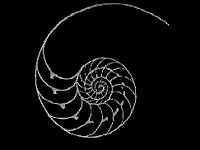
[film] 1998 In Darren Aronofsky's Pi, computer freak Max believes that the mathematics is the true language of nature, and that every action in the world, no matter how random, is intricately ordered and patterned. The belief drives him into the obsessive search for the 216-digit number supposed to be the code behind the stock market, chaos theory, Kabbalistic "name of God" and the life itself.  |
|

|

|

|

|

[lit] 1995 Mary-Anne Breeze [aka Mez] starts to publish the code poems on her website using the polysemic language system termed mezangelle, which evolved from multifarious email exchanges, computer code flavoured language and net iconographs. "To mezangelle means to take words/wordstrings/sentences and alter them in such a way as to extend and enhance meaning beyond the predicted or the expected. It's similar to making plain text hypertextual via the arrangement and dissection of words. Mezangelling attempts to expand traditional text parameters through layered/alternative/code based meanings embedded into meta-phonetic renderings of language."   |
|

|

|

|

|
[sci] 1990 Genestheticist Joe Davis creates the Microvenus icon. He encodes visual icon representing the external female genitalia and an ancient Germanic rune representing the female Earth into binary code and consequently into a 28-bases long DNA molecule. DNA string is incorporated into genom of E. coli bacteria which multiplies and creates billions of copies of genetic representations of Microvenus icon.  |
|

|

|

|

|
[art] 1978 Herbert Franke's Cascade is a live transformation of music into graphics. The underlying program for a Apple II GS converts sounds in relation to the frequencies into pictures.  |
|

|

|

|

|
[art] 1965 First three exhibitions of computer art open in New York and Stuttgart. Generative Computergrafik is launched in February in Technische Hochschule Stuttgart by Max Bense and curated by Frieder Nake and Georg Nees. In April, Computer-Generated Pictures opens at Howard Wise Gallery in NYC, curated by Michael Noll and Bela Julesz. Stuttgart show reopens in November in Galerie Wendelin Niedlich Stuttgart. The majority of the works doesnt come from artists, but mathematicians and programmers instead. High amount of works are parallels to constructivist, suprematist and op-art works.  |
|

|

|

|

|
[sci] 1963 Ivan Sutherland's Sketchpad is device which made it possible for computer user to interactively create images on his screen. Features include pop-up menus, constraint-based drawing, hierarchical modeling, utilized lightpen for interaction.  |
|

|

|

|

|
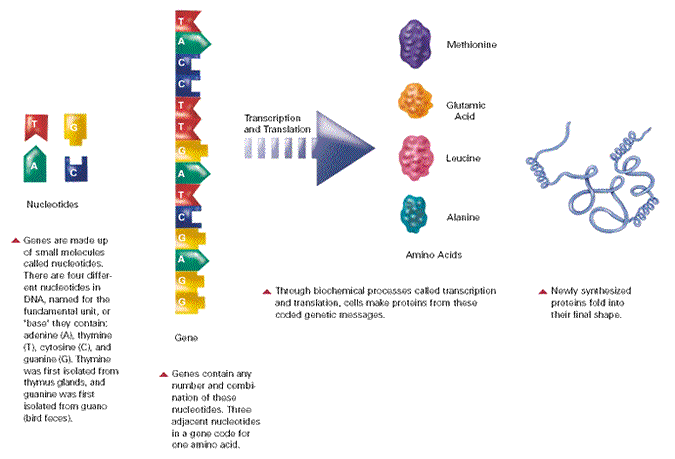
[sci] 1961 Marshall Nirenberg discovers the first triplet—a sequence of 3 nucleotide bases of DNA that codes for one of the 20 amino acids that serve as the building blocks of proteins. Subsequently, within 5 years, the entire genetic code is deciphered.   |
|

|

|

|

|
[sci] 1955 Pierre Teilhard de Chardin in his Le Phenomene Humain proposes a general organizing principle for both internal structuration and external interaction of the system. He says, that 3 mechanisms were used sequentially during evolution: structure, code and intelligence. 1, the lithophase, the lithogenesis, the lithosphere, organizing principle of dead matter, the structure of the system, enabling and preventing some possible moves and combinations, thus enhancing and limiting coincidence, and elevating evolution from chaos. 2, the biophase, the biogenesis, the biosphere, organizing principle of living matter, a structuring code (DNA), in which the experience of the past is recorded, so that the organisms don't have to "re-invent warm water" each time, at the same time a cyclic way of existence being developed, to enable more frequent procreations and more rapid development, and at a certain moment an intercellular (and inter-organismic) combination of codes -i.e. experiences- (sexual multiplication) being introduced, further accelerating evolution. 3, the noophase, the noogenesis, the noosphere, insight as an organizing principle of thinking matter, intelligence, also called consciousness, where complementary to the instincts, a learning ability is developed, and the development of intelligence is further enhanced by interaction possibilities (communication) starting with spoken language, enhanced by written communication (that got a boost with Gutenberg's printing tool, books and press), electric communication (phone, radio, TV) and, eventually, Internet. Seen from the inside, the noosphere, to be able to perform its steering function, includes an "image" not only of existing reality, but also of its ruling laws, and, most importantly, of its developmental possibilities and the practical ways to achieve this evolutionary process. Moreover, this "intelligence", this "consciousness" is shared and "crossfertilized" by more and more communicating people -ideally by all-, enhancing and stimulating its own progress (as sexual multiplication enhanced biogenesis).   |
|

|

|

|

|
[art] 1952 Matematik Ben F Laposky začína vytvárať prvé grafické obrazy generované analógovým počítačom, osciloskopom. Tvorené vzory lúčov nahráva na vysokorýchlostný film, z neho produkuje fotografie, oscilóny.  |
|

|

|

|

|

[snd] 1951 John Cage composes 43 minutes long piano piece Music of Changes using I Ching chance operations in order to create different charts for various parameters: tempi, dynamics, sounds and silences, durations and superimpositions.  |
|

|

|

|

|
[sci] 1882 Ferdinand von Lindemann: π (3.14159..) is a transcendental number--cannot be the solution to any polynomial expression of rational numbers.   |
|

|

|

|

|

[sci] 1860 Gregor Mendel cross-pollinates peas with yellow and green seeds. First offspring generation has always exclusively yellow seeds. Following generation consistently has a 3:1 ratio of yellow to green seeds. Mendel concludes, that the inheritance of each trait is determined by "units" or "factors" (now called genes) that are passed on to descendents unchanged; that an individual inherits one such unit from each parent for each trait and that a trait may not show up in an individual but can still be passed on to the next generation.  |
|

|

|

|

|
[sci] 1761 Johann Heinrich Lambert: π (3.14159..) is not a rational number, i.e., it cannot be expressed as a ratio of two integers.   |
|

|

|

|

|

[art] 1509 Leonardo da Vinci provides illustrations of five Platonic solids for a dissertation published by Luca Pacioli entitled De Divina Proportione. He calls it the "sectio aurea," which is Latin for golden section.   |
|

|

|

|

|

[sci] -300 Euclid in his Elements divides a line at the 0.61803.. point into its extreme and mean ratio and gives the first clear definition of (the number today known as) Phi. This statement gives rise to the word golden mean. He also connects this number to the construction of a pentagram.  |
|

|

|

|

|

[*] -450 Greek knowledge of (the number today known as) Phi (1.61803..) impact the building of the Parthenon. It is found throughout nature, in structure nautilus shells, the size of leaves, the branching patterns of trees, and in the human body. The Greeks believe the number describes the dimensions of average, and by inference "ideal", body features such as the face, the torso, and the proportions of arms and legs to the size of the body. Phi is considered auspicious and aesthetically pleasing and is used for other creations, even if not dictated by nature, and is used as a guide for accurately creating human likenesses in painting and sculpture, also in philosophy, paideia, and in buildings and courtyards architecture.   |
|

|

|

|

|

[*] -1650 Egyptians use (the number today known as) Phi in the design of their pyramids, i.e the Great Pyramid at Giza.   |
|

|

|
|

